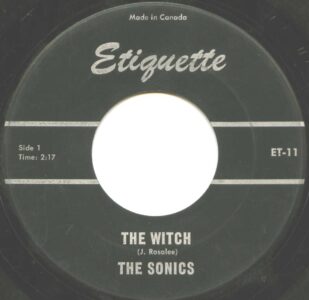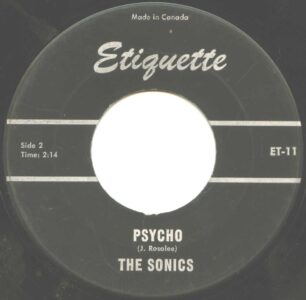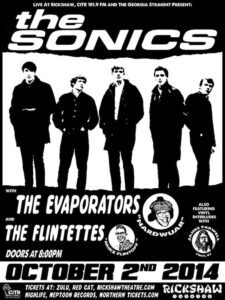#381: The Witch/Psycho by The Sonics
Peak Month: March 1965
“The Witch”
9 weeks on CFUN’s Vancouver Chart
Peak Position ~ #2
Peak Position on Billboard Hot 100 ~ did not chart
YouTube: “The Witch”
Lyrics: “The Witch”
4 weeks on CFUN’s Vancouver Chart
Peak Position ~ #4
Peak Position on Billboard Hot 100 ~ did not chart
YouTube: “Psycho”
Lyrics: “Psycho”
The Sonics were formed in 1960 in Tacoma when teenage guitarist Larry Parypa was encouraged by his parents to take his budding musical talents to the next level. A number of lineup changes ensued over the first several years. The band was an instrumental group until 1962, when Marilyn Lodge joined and became the bands first vocalist. She was replaced in 1963 by a local frontman named Ray Michelsen. At the time the bands’ drummer, Bill Dean, was not totally committed to the musical project. In time he left the band. Elsewhere on the musical scene in Tacoma were The Searchers (distinct from the British band the Searchers) who formed in 1961. The Searchers included Gerry Roslie on keyboards, Rob Lind on saxophone and Bob Bennett on drums. In search of a new drummer for the Sonics, once Larry Parypa heard the Searchers in concert – a new lineup fell into place.
By 1964 the Sonics consisted of Gerry Roslie on lead vocals and keyboards, Andy Parypa on bass guitar and backing vocals, Larry Parypa on rhythm guitar and backing vocals, Rob Lind on saxophone, and Bob Bennett on drums. Roslie was born in 1944 in Tacoma. Larry and Andy Parypa were both born in Bremerton, Washington: Andy in 1942 and Larry in 1944. Rob Lind was born in 1942, while Bob Bennett’s birthdate (and birth place) is not mentioned in any article I searched.
With Roslie as lead singer the band started playing gigs at the Red Carpet at 5212 South Tacoma Way in Tacoma, Olympia’s Skateland, the Evergreen Ballroom, Perl’s in Bremerton, the Spanish Castle Ballroom on Old Highway 99 – north of Tacoma, and St. Mary’s Parish Hall.
The Sonics were soon scouted by Buck Ormsby, bassist for popular Northwest band the Wailers. Ormsby arranged to have the Sonics signed to the Wailers’ own label, Etiquette Records. The first single the Sonics cut was “The Witch” (with Little Richard’s “Keep A-Knockin'” as the B-side), in November 1964. As the sales took off, “The Witch” was re-issued in early 1965 with “Psycho” on the B-side.

“The Witch” was written by Gerry Rosalie, but credited to J. Rosalee. The song concerns a new girl in town who is “an evil chick.” Not only is she just any old “evil chick,” in fact she’s a “witch.” With her long black hair, and big black car, this witch can make people “itch.” Late at night she walks around when other people are sleeping. The narrator of the song warns people that if the witch knocks at their door the occupants should yell “get away.” Having given listeners the low down, the narrator warns “you better be careful, before it’s too late.”
In ancient civilizations wise women made house calls, delivered babies, dealt with infertility, and cured impotence. According to Biblical scholar Carole Fontaine, “What’s interesting about them is that they are so clearly understood to be positive figures in their society. No king could be without their counsel, no army could recover from a defeat without their ritual activity, no baby could be born without their presence.” In ancient times witches were associated with healing and goodness.
However, between 1347 and 1363 the black plague spread through England, continental Europe and the Middle East it killed between 900,000 and one million people. In the face of such devastation – with half the population of Europe decimated, people began looking for scapegoats. There were many: jews, gypsies and women believed to be witches. Single adult women were believed to worship in large nocturnal assemblies, where they practiced promiscuous sex, danced naked, had ravenous feasts and ate the flesh of human infants. During these assemblies church officials believed that the Devil would appear and take part in an unbounded orgy with all those present. Catholic inquisitors Jacob Springer and Henrik Kramer wrote in their 1487 book Malleus Maleficarum that women “are evil, lecherous, vein, and lustful. All witchcraft comes from carnal lust, which is, in women, insatiable.”
It is from the legacy from the Middle Ages believe that witches were evil, that the Sonics’ “The Witch” draws upon. “The Witch” was immensely popular with local kids, and went on to become the biggest selling local single in the history of the Northwest, despite its radio airplay being restricted because of its bizarre subject matter. “The Witch” was too hot to handle for Seattle area radio stations who would only play the single after 3 PM so as not to upset the housewives with what they initially perceived as “devil music.” The single sold 10,000 copies in its first two weeks.
“The Witch” climbed to #2 in Seattle and Vancouver (BC), #4 in Sacramento (CA), #6 in Vancouver (WA), #8 in Salem (OR), #9 in Lewiston (ID), and #11 in San Jose (CA).
Early in 1965 Etiquette released the Sonics’ debut album, Here Are The Sonics, which was produced at Audio Recording in Seattle, Washington. It was recorded on a two-track tape recorder, with only one microphone to pick up the entire drum kit. The album contained covers of Little Richard’s “Good Golly Miss Molly”, Chuck Berry’s “Roll Over Beethoven”, Ray Charles’ “Night Time Is The Right Time” and the Contours’ “Do You Love Me”.
Among the tracks on Here Are The Sonics was “Psycho”.

“Psycho” was also written by Gerry Rosalie and credited to his alias J. Rosalee. The narrator in the song explains that his “baby” is driving him “crazy.” In fact he’s “losing (his) mind” and is “psycho.” In 1960 film director Alfred Hitchcock released a psychological thriller titled Psycho. It set a new level of acceptability for violence, deviant behavior and sexuality in American films. In the film a young woman named Marion Crane steals $40,000 from her real-estate office in Phoenix, Arizona. On route to see her boyfriend Sam in the fictional town of Fairvale, California. Caught in a rainstorm north of Bakersfield, Marion stops at the Bates Motel. The proprietor, Norman Bates, is haunted by his mentally ill mother (actually an alternate personality, as his mother died ten years earlier in a murder-suicide). Norman tells Marion about his plight, and later kills her with a knife in an iconic shower scene.
The film was based on the 1959 novel, Psycho, written by Robert Bloch. The novelist used an uncommon plot structure: he repeatedly introduced sympathetic protagonists, then killed them off. This played on his reader’s expectations of traditional plots, leaving them uncertain and anxious. Hitchcock recognized the effect this approach could have on audiences, and utilized it in his adaptation, killing off Janet Leigh’s character – Marion Crane – at the end of the first act. This daring plot device, coupled with the fact that the character was played by the biggest box-office name in the film, was a shocking turn of events in 1960. The shower scene has become a pop culture touchstone and is often regarded as one of the most terrifying scenes ever filmed. Psycho received four Academy Award nominations in April 1961.
With the film Psycho a cultural reference, that word – psycho – was just waiting for a garage band like the Sonics to use in the title of a song. “Psycho” evoked the shower scene in Psycho by being the song’s title. Anyone who was being driven crazy and going out of their mind was a person to be very afraid of.
“Psycho” peaked at #4 in both Seattle and Vancouver (BC), and #18 in Bend (OR). It was a #1 hit in Orlando (FL) in April 1967.
With the success of “The Witch”/”Psycho”, the Sonics proceeded to open concerts in Seattle for The Beach Boys, the Mamas & The Papas, Jay & the Americans and The Shangri-Las.
In 1966 The Sonics released their second studio album The Sonics Boom. The album title was a play on the term sonic boom. A sonic boom is the sound associated with the shock waves created whenever an object travels through the air faster than the speed of sound. Sonic booms generate enormous amounts of sound energy, sounding similar to an explosion or a thunderclap to the human ear.
The liner notes on The Sonics Boom noted “Few artists have ever captured the Pacific Northwest scene as have the Sonics with their fresh and dominating sound. Their singles and albums have consistently listed among the top sellers. The Sonics popularity in the dance field has exploded, producing record-breaking crowds wherever they go. Now comes The Sonics Boom, and boom they do with more exciting originals like “Cinderella” and “He’s Waiting”. Take special note of the all-new and different rendition of the rock standard “Louie Louie”, and many more…all in the style that only the Sonics could capture.”
“The Sonics are known by their many followers for possessing a tremendous musical sound as well as individual personality and showmanship. Gerry Rosalie, who writes and sings most of the Sonics material, also drives the organ (which is the only way to describe his work). The other Sonics are Andy Parypa, leader and bass guitarist; Larry Parypa, whose lead guitar provides the basis for their original “sound”; Rob Lind, sax and vocal, and Bob Bennett, the drummer with the exploding beat and smile as well. The group has an unusual vocalization plus a space-age, plus-beat sound….All of this make the Sonics! Next time you hear a loud boom and your windows rattle, it’s probably a sonic boom alright, but on the other hand, it might be The Sonics Boom.”
The Sonics Boom included covers of “Let The Good Times Roll” by Shirley and Lee (1956), “Don’t You Just Know It” by Huey “Piano” Smith (1958), “Hitch Hike” by Marvin Gaye (1963), and “Jenny Jenny” by Little Richard (1956).
In September 1966 the Sonics charted “You’ve Got Your Head On Backwards” to #10 in Seattle and Richland (WA), and #15 in Vancouver (BC). While “The Witch”, in another re-issue in the winter of 1966 climbed to #1 in Salt Lake City, #7 in Boise (ID) and #12 in Eugene (WA) and the Top 20 in Hoquiam (WA).
In 1967 the band released a third studio album Introducing The Sonics. It included a cover of the Bo Diddley R&B classic from 1955 “I’m A Man”. The original band fell apart in 1967, with members leaving to attend university or join other bands. Saxophonist Rob Lind became a fighter pilot in the Vietnam War. Eventually, all of the original members left, with new members continuing on with the name Sonics. Bob Bennett went on to drum for Pacific Northwest band ICE from 1968-70. Both Andy and Larry Parypa were in a band called Charlie and the Tuna’s from around 1980 to 1996. Larry went on to form Olympia (WA) based ICE AGE from 2000 to 2005.
The original Sonics reunited briefly in 1972 for a live show at Seattle’s Paramount Theater, with the recording of this show released as Live Fanz Only by Etiquette. In 1980, a new Sonics fronted by Gerry Roslie recorded the album Sinderella, which featured versions of the original band’s material.
The emergence of punk rock in the late 70’s and grunge in the 90’s led to new interest in the Sonics, and much of their material was re-released by labels in the US and Europe. Larry and Andy Parypa continued performing with various bands in the Northwest, while Roslie, Lind, and Bennett pursued careers outside of music.
A further surge of interest in the Sonics was sparked by the use of their hard-rocking version of Richard Berry’s “Have Love, Will Travel” in a 2004 Land Rover TV ad.
In 2007, the Sonics reunited again, this time for the Cavestomp garage rock festival in Brooklyn (November 2–4, 2007). The line up featured original members Gerry Roslie on vocals/keyboards, Larry Parypa on guitar, and Rob Lind on tenor sax, with Ricky Lynn Johnson (of the Wailers) on drums and Don Wilhelm (of the Daily Flash) on bass and vocals.
In 2008, the Sonics recorded a live session for Mark Lamarr’s BBC Radio 2 show God’s Jukebox on March 22. They played their first ever shows in London on Friday March 21 and Sunday March 23; later that year, “Have Love, Will Travel” was prominently featured on the soundtrack of Guy Ritchie’s 2008 action-crime film RocknRolla.
Since then, they have played the Primavera Festival in Barcelona, followed by Bilbao, then the Sjock Festival in Belgium, Norway, and the Azkena Rock Festival in Vitoria in the Basque Country.
Their first show in their home region since their last Seattle reunion in 1972 was on October 31, 2008 at the Paramount Theatre in Seattle, where they were introduced and joined onstage for a couple numbers by Steven Van Zandt. Kent Morrill (front man of the Wailers) made a surprise appearance to help sing his signature song “Dirty Robber”, which was a track from the Sonics first album. Bob Bennett was also present to sit in on drums albeit only for a few songs and only while Ricky Lynn Johnson played in unison.
The Sonics appeared in concert in Vancouver (BC) at the Rickshaw Club on October 2, 2014.

In 2015 the Sonics released a new album titled This Is The Sonics. And in 2018 a documentary was released titled BOOM! A Film About The Sonics.
February 12, 2021
Ray McGinnis
References:
Jon Hueber, “‘BOOM! A Film About The Sonics’ Review: A True Rock ‘N Roll Journey,” Electric Bento, May 3, 2019.
“BOOM! A Film About The Sonics,” sonics film.com.
Rebecca Bollwitt, “The Sonics at the Rickshaw in Vancouver,” miss604.com, September 15, 2014.
Steven, “The Sonics Net Worth and Earnings 2021,” MCM News, January 18, 2021.
“Psycho (1960),” Frenchfilms.com.
Joseph W. Smith III, The Psycho File: A Comprehensive Guide to Hitchcock’s Classic Shocker, (McFarland & Company, 2009).
“The History Of Witches: How Christianity And Misogyny Turned Revered Healers Into Wicked Pariahs,” All Thats Interesting.com, October 31, 2015.
Carole Fontaine, With Eyes of Flesh: The Bible, Gender and Human Rights, (Sheffield Phoenix Press, 2008).
“The Witch” #2: “C-FUNTASTIC FIFTY,” CFUN 1410 AM, Vancouver, BC, March 27, 1965.
“Psycho” #4: “C-FUNTASTIC FIFTY,” CFUN 1410 AM, Vancouver, BC, March 20, 1965.
For more song reviews visit the Countdown.

Leave a Reply